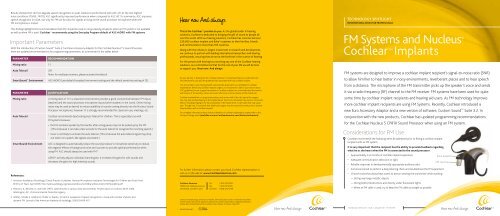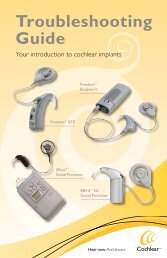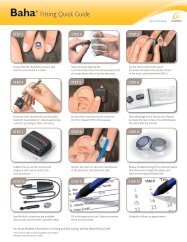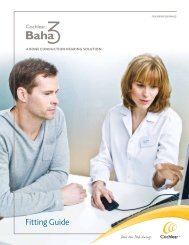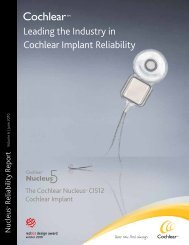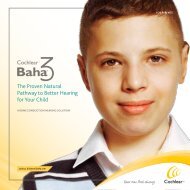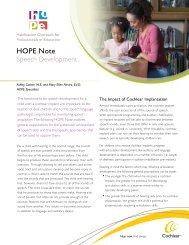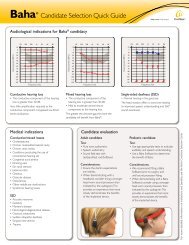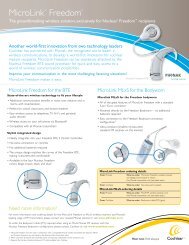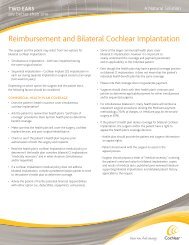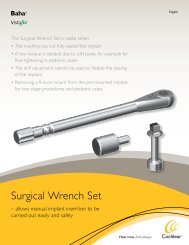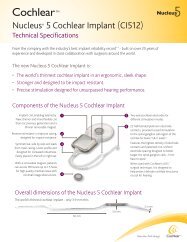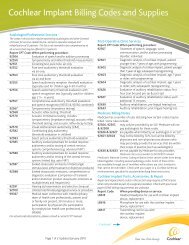FM Systems and Nucleus® Cochlear™ Implants - For professionals ...
FM Systems and Nucleus® Cochlear™ Implants - For professionals ...
FM Systems and Nucleus® Cochlear™ Implants - For professionals ...
Create successful ePaper yourself
Turn your PDF publications into a flip-book with our unique Google optimized e-Paper software.
esults showed asc did not degrade speech recognition in quiet relative to performance with asc off. at the two highest<br />
noise conditions (70/63, 74/70), asc significantly improved performance when compared to asc off. to summarize, asc improves<br />
speech recognition in noise, not only for <strong>FM</strong> use but also for signals arriving at the sound processor microphone when the<br />
<strong>FM</strong> microphone is muted.<br />
this finding highlights the recommendation that asc should be used in noisy listening situations when an <strong>FM</strong> system is not available<br />
as well as when <strong>FM</strong> is used. cochlear recommends using the everyday program default of ASc+ADRo with <strong>FM</strong> systems.<br />
important parameters<br />
With the introduction of custom sound suite 3.1 <strong>and</strong> euro accessory adaptor for the cochlear nucleus ® 5 sound processor,<br />
there are updated recommendations for programming parameters, as summarized in the tables below.<br />
PARAMETER RECOMMENDATION<br />
Mixing ratio 1:1<br />
Auto Telecoil off<br />
note: for neckloop receivers, please activate the telecoil<br />
SmartSound environment asc+aDro (use default everyday environment setting <strong>and</strong> the default sensitivity setting of 12)<br />
PARAMETER JUSTIFICATION<br />
Mixing ratio a mixing ratio of 1:1 in a classroom environment provides a good compromise between <strong>FM</strong> inputs<br />
(teacher) <strong>and</strong> the sound processor microphone inputs (other students in the room). other mixing<br />
ratios may be used as desired to reduce audibility of sounds coming directly into the nucleus sound<br />
processor microphones, however 1:1 is strongly recommended for classroom use, meetings, etc.<br />
Auto Telecoil cochlear recommends deactivating auto telecoil for children. this is especially true with<br />
<strong>FM</strong> systems because:<br />
• the first sentence spoken by the teacher after a long pause may not be picked up by the <strong>FM</strong>.<br />
(this is because it can take a few seconds for the auto telecoil to recognize the incoming speech.)<br />
• music is not likely to activate the auto telecoil. (This is because the auto telecoil signal may drop<br />
out when non-speech-like signals are present.)<br />
SmartSound environment asc is designed to automatically reduce the sound processor’s microphone sensitivity to reduce<br />
the negative effects of background noise <strong>and</strong> is proven to provide optimal performance when<br />
using <strong>FM</strong>. asc should always be used with <strong>FM</strong>. 3<br />
References:<br />
aDro ® actively adjusts individual channel gains. it increases the gains for soft sounds <strong>and</strong><br />
decreases the gains for high intensity sounds.<br />
1 american academy of audiology clinical practice guidelines. remote Microphone assistance technologies for children <strong>and</strong> youth from<br />
Birth to 21 years. april 2008. http://www.audiology.org/resources/documentlibrary/Documents/hatguideline.pdf<br />
2 pearsons, K., Bennett, r., <strong>and</strong> Fidel. (1977). speech levels in various noise environments. project report on contract 68 01-2466.<br />
Washington, Dc, Us environmental protection agency.<br />
3 Wolfe J, schafer e, heldner B, Mulder h, Ward e, Vincent B. evaluation of speech recognition in noise with cochlear implants <strong>and</strong><br />
dynamic <strong>FM</strong>. Journal of the american academy of audiology. 2009;20:409-421.<br />
This is the cochlear promise to you. As the global leader in hearing<br />
solutions, Cochlear is dedicated to bringing the gift of sound to people all<br />
over the world. With our hearing solutions, Cochlear has reconnected over<br />
230,000 cochlear implant <strong>and</strong> Baha ® recipients to their families, friends<br />
<strong>and</strong> communities in more than 100 countries.<br />
Along with the industry’s largest investment in research <strong>and</strong> development,<br />
we continue to partner with leading international researchers <strong>and</strong> hearing<br />
<strong>professionals</strong>, ensuring that we are at the forefront in the science of hearing.<br />
<strong>For</strong> the person with hearing loss receiving any one of the Cochlear hearing<br />
solutions, our commitment is that for the rest of your life we will be here<br />
to support you. hear now. And always<br />
as your partner in hearing for life, cochlear believes it is important that you underst<strong>and</strong> not<br />
only the benefits, but also the potential risks associated with any cochlear implant.<br />
you should talk to your hearing health care provider about who is a c<strong>and</strong>idate for cochlear<br />
implantation. Before any cochlear implant surgery, it is important to talk to your doctor about<br />
cDc guidelines for pre-surgical vaccinations. cochlear implants are contraindicated for patients<br />
with lesions of the auditory nerve, active ear infections or active disease of the middle ear.<br />
cochlear implantation is a surgical procedure, <strong>and</strong> carries with it the risks typical for surgery.<br />
you may lose residual hearing in the implanted ear. electrical stimulation may result in some side<br />
effects, including ringing in the ear, stimulation of the facial nerve; in rare cases this may cause<br />
pain. though rare, it is possible that additional surgery may be required at some point to resolve<br />
complications with a cochlear implant.<br />
<strong>For</strong> complete information about risks <strong>and</strong> benefits of cochlear implantation, please refer to the<br />
nucleus package insert (available at www.cochlearAmericas.com/nucleusindications).<br />
<strong>For</strong> further information please contact your local cochlear representative or<br />
visit us on the web at: www.cochlearAmericas.com<br />
cochlear Americas<br />
13059 east peakview avenue<br />
centennial, co 80111 Usa<br />
Cochlear, the elliptical logo, SmartSound, Freedom, ESPrit <strong>and</strong> Custom Sound are trademarks of Cochlear<br />
Limited. Nucleus <strong>and</strong> Adro are registered trademarks of Cochlear Limited. Baha is a registered trademark of<br />
Cochlear Bone Anchored Solutions AB, a Cochlear Group Company. © Cochlear Limited 2011<br />
FUN1276 ISS2 JAN11<br />
tel: 1 303 790 9010<br />
Fax: 1 303 792 9025<br />
toll Free: 1 800 523 5798<br />
Technology SpoTlighT<br />
INFORMATIONAL seRIes FOR pROFessIONALs<br />
<strong>FM</strong> <strong>Systems</strong> <strong>and</strong> Nucleus ®<br />
Cochlear <strong>Implants</strong><br />
<strong>FM</strong> systems are designed to improve a cochlear implant recipient’s signal-to-noise ratio (snr)<br />
to allow him/her to hear better in noisy environments, reverberant places <strong>and</strong> to hear speech<br />
from a distance. the microphone of the <strong>FM</strong> transmitter picks up the speaker’s voice <strong>and</strong> sends<br />
it via a radio frequency (rF) channel to the <strong>FM</strong> receiver. <strong>FM</strong> systems have been used for quite<br />
some time by cochlear implant recipients <strong>and</strong> hearing aid users. as <strong>FM</strong> technology improves<br />
more cochlear implant recipients are using <strong>FM</strong> systems. recently, cochlear introduced a<br />
new euro accessory adaptor <strong>and</strong> a new version of software, custom sound suite 3.2. in<br />
conjunction with the new products, cochlear has updated programming recommendations<br />
for the cochlear nucleus 5 cp810 sound processor when using an <strong>FM</strong> system.<br />
considerations for <strong>FM</strong> Use<br />
cochlear recommends the following items be addressed prior to fitting a cochlear implant<br />
recipient with an <strong>FM</strong> system.<br />
It is very important that the recipient has the ability to provide feedback regarding<br />
what he or she hears when the <strong>FM</strong> is connected to the sound processor<br />
• Approximately 3-6 months of cochlear implant experience<br />
Euro adaptor<br />
• Adequate communication skills (oral or sign)<br />
<strong>FM</strong> receiver<br />
• Reliable responses to developmentally-appropriate auditory tasks<br />
• Someone trained to perform a daily listening check <strong>and</strong> troubleshoot the <strong>FM</strong> equipment<br />
• Choose a seat that allows best access to person wearing the transmitter while avoiding:<br />
— sitting near large metallic objects<br />
— sitting behind obstructions <strong>and</strong> directly under fluorescent lights<br />
— When an <strong>FM</strong> cable is used, try to keep the <strong>FM</strong> cable as straight as possible<br />
technology spotlight :: issUe 3 :: JanUary 2011 :: <strong>FM</strong> systeMs
ear-level <strong>FM</strong> receivers listening check clinical results using<br />
When using an ear-level <strong>FM</strong> receiver <strong>and</strong> the transmitter <strong>and</strong><br />
receiver are turned on, a wireless connection is established<br />
between the two devices. Most current devices will<br />
automatically synchronize to the same channel.<br />
the new euro accessory adaptor connects an ear-level<br />
receiver to the cochlear nucleus ® 5 sound processor via<br />
the accessory socket in three steps:<br />
1. insert the <strong>FM</strong> receiver into the three pin socket on the<br />
euro accessory adaptor<br />
2. insert the euro accessory adaptor into the sound<br />
processor’s accessory socket<br />
3. switch on the <strong>FM</strong> receiver (the nucleus 5 sound<br />
processor will automatically detect the euro accessory<br />
adaptor <strong>and</strong> <strong>FM</strong> receiver when programmed with<br />
custom sound suite 3.1 or higher)<br />
neckloop systems<br />
a neckloop consists of a covered wire that is physically<br />
connected to an <strong>FM</strong> receiver. the neckloop <strong>and</strong> attached<br />
receiver are worn around the neck. the sound processor’s<br />
telecoil is used to pick up the electromagnetic field that<br />
the neckloop produces. When the transmitter <strong>and</strong> receiver<br />
are turned on, a wireless connection is established between<br />
the two devices. Most current devices will automatically<br />
synchronize to the same channel.<br />
Bodyworn <strong>FM</strong> receivers<br />
the bodyworn <strong>FM</strong> receiver is used in combination with<br />
an <strong>FM</strong> transmitter <strong>and</strong> microphone. <strong>For</strong> cochlear implant<br />
recipients using this type of receiver, a cable is used to<br />
connect the nucleus 5 sound processor to the receiver.<br />
the Freedom accessory adaptor is needed to connect<br />
the processor end of the esprit <strong>FM</strong> cable into the<br />
accessory socket of the sound processor.<br />
technology spotlight :: issUe 3 :: JanUary 2011 :: <strong>FM</strong> systeMs<br />
one way to verify proper functioning is by using the monitor<br />
earphones to do a listening check of the <strong>FM</strong> system. the<br />
monitor earphones will allow you to listen to the signal from<br />
the <strong>FM</strong> system to ensure it sounds satisfactory. this can be<br />
accomplished in five steps:<br />
1. insert the monitor earphones into the accessory socket<br />
of the processor<br />
2. ensure your <strong>FM</strong> receiver <strong>and</strong> connecting device (euro<br />
accessory adaptor or the Freedom accessory adaptor used<br />
with an <strong>FM</strong> cable) are joined together<br />
3. turn the <strong>FM</strong> receiver <strong>and</strong> transmitter on<br />
4. insert the euro accessory adaptor (with <strong>FM</strong> receiver<br />
attached) into the socket on the monitor earphones. if you<br />
are not using an ear-level <strong>FM</strong> system you will need to use<br />
the Freedom accessory adaptor with the esprit <strong>FM</strong> cable<br />
** It is important to plug the Monitor Earphones into the<br />
Accessory Socket before you connect the adaptor <strong>and</strong> <strong>FM</strong><br />
receiver to the Monitor Earphones. This will ensure that the<br />
accessory is recognized by the Monitor Earphones.<br />
5. Use the Monitor earphones to listen to the signal from the<br />
<strong>FM</strong> system<br />
performing an informal listening check with <strong>and</strong> without <strong>FM</strong><br />
in quiet <strong>and</strong> noise at some distance e.g., 6 feet in quiet <strong>and</strong> in<br />
noise is also recommended.<br />
• Have recipient repeat (or action): Ling Sounds (ah, oo, ee,<br />
sh, ss, mm), count numbers, count number of syllables<br />
in word, indicate long or short sounds or follow simple<br />
instructions: e.g. clap your h<strong>and</strong>s.<br />
confirmation of <strong>FM</strong> benefit<br />
as with any hearing aid fitting or cochlear implant<br />
programming, a verification check to ensure benefit <strong>and</strong> proper<br />
functioning of the <strong>FM</strong> system is recommended. Verification<br />
checks are particularly important for children, who may not<br />
always be able to provide accurate feedback regarding sound<br />
quality <strong>and</strong> benefit from an <strong>FM</strong> system.<br />
a brief review of testing for <strong>FM</strong> benefit is included with this<br />
piece, but more detailed information on test recommendations<br />
<strong>and</strong> guidelines can be found in the american academy of<br />
audiology clinical practice guidelines document on remote<br />
Microphone hearing assistance technologies for children <strong>and</strong><br />
youth from Birth to 21 years. 1<br />
one way to verify the benefit from an <strong>FM</strong> system is to<br />
complete testing in a sound booth. Verification testing in a<br />
sound booth should include testing in four conditions:<br />
• Speech recognition testing in quiet without <strong>FM</strong><br />
• Speech recognition testing in quiet with <strong>FM</strong><br />
• Speech recognition testing in noise without <strong>FM</strong><br />
• Speech recognition testing in noise with <strong>FM</strong><br />
please note that the recommended speech level for each<br />
scenario is 50 dB hl (65 dB spl) to represent the teacher’s<br />
voice at a listening distance of 2 meters. 2 a variety of<br />
presentation levels could be considered to represent different<br />
listening distances, such as 55 dB hl (70 dB spl) to represent<br />
the teacher’s voice at 1 meter, or 40 dB hl (55 dB spl) to<br />
represent conversational levels of speech from 2 meters.<br />
to maintain a realistic test setting, speech <strong>and</strong> noise should<br />
not be presented from the same loudspeaker as this is not<br />
representative of a typical classroom environment where the<br />
<strong>FM</strong> microphone is near the teacher’s mouth <strong>and</strong> the noise is<br />
typically diffuse.<br />
scenario 1: speech recognition testing in quiet without <strong>FM</strong><br />
• <strong>FM</strong> receiver not attached to sound processor<br />
• Speech presented at 65 dB SPL (to represent typical level<br />
of teacher’s voice in a classroom setting)<br />
<strong>FM</strong> ReMoveD<br />
Speech – 65 dB SPL<br />
scenario 2: speech recognition testing in quiet with <strong>FM</strong><br />
• Activate <strong>FM</strong> transmitter microphone <strong>and</strong> turn on <strong>FM</strong> receiver<br />
• Student remains in same test position<br />
• Evaluate speech recognition performance with transmitter<br />
microphone on <strong>and</strong> placed next to speaker (typically<br />
hung 6 inches from speaker)<br />
• Speech presented at 65 dB SPL<br />
<strong>FM</strong> on<br />
Speech – 65 dB SPL<br />
Speech<br />
180 DegRee plAceMenT<br />
Speech<br />
180 DegRee plAceMenT<br />
<strong>For</strong> additional information, please review the american<br />
academy of audiology clinical practice guidelines for remote<br />
Microphone hearing assistance technologies for children <strong>and</strong><br />
youth from Birth to 21 years. 1<br />
speech recognition performance using the <strong>FM</strong> system in noise<br />
should offer a significant benefit over using the sound processor<br />
alone in noise. ideally, speech recognition testing results using the<br />
<strong>FM</strong> system in noise should be close to the results when tested in<br />
quiet. speech recognition performance is tested in quiet with <strong>and</strong><br />
without the <strong>FM</strong> to confirm the <strong>FM</strong> system is working properly<br />
<strong>and</strong> is not interfering with performance. also, if tested at a low<br />
presentation level the <strong>FM</strong> performance should be better.<br />
scenario 3: speech recognition testing in noise without <strong>FM</strong><br />
• <strong>FM</strong> transmitter microphone on mute or off, <strong>FM</strong> receiver<br />
not attached to sound processor<br />
• Speech presented at 65 dB SPL<br />
• Noise presented at 65 dB SPL to represent a 0 dB SNR<br />
(can be adjusted by changing presentation levels)<br />
<strong>FM</strong> ReMoveD<br />
Speech – 65 dB SPL<br />
Noise – 65 dB SPL<br />
SNR – 0 dB SPL<br />
noiSe<br />
scenario 4: speech recognition testing in noise with <strong>FM</strong><br />
• Activate <strong>FM</strong> transmitter microphone <strong>and</strong> turn on <strong>FM</strong> receiver<br />
• Student remains in same test position<br />
• Evaluate speech recognition performance with transmitter<br />
microphone on <strong>and</strong> placed next to speaker (typically hung<br />
6 inches from speaker)<br />
• Speech presented at 65 dB SPL<br />
• Noise presented at 65 dB SPL to represent a 0 dB SNR<br />
(can be adjusted by changing presentation levels)<br />
<strong>FM</strong> on<br />
Speech – 65 dB SPL<br />
noise – 65 dB SPL<br />
SnR – 0 dB SPL<br />
NOISE<br />
Speech<br />
180 DegRee plAceMenT<br />
Speech<br />
180 DegRee plAceMenT<br />
smartsound <br />
with <strong>FM</strong> systems<br />
the new smartsound everyday default of asc+aDro is<br />
advantageous when using <strong>FM</strong> systems. Wolfe <strong>and</strong> colleagues<br />
(2009) examined the effects of using asc, i.e. comparison<br />
of asc on versus asc off. eleven adult subjects listened to<br />
speech in noise with their Freedom sound processor while<br />
using either traditional <strong>FM</strong> or the dynamic <strong>FM</strong> system, inspiro,<br />
available from phonak . it should be noted that some, but not<br />
all of these subjects used aDro in their everyday Map that<br />
was used in the <strong>FM</strong> evaluation. stimuli consisted of two lists of<br />
hint sentences for each condition. sentences were presented<br />
at 85 dBa at the location of the <strong>FM</strong> transmitter microphone,<br />
<strong>and</strong> 60 dBa at the location of the cochlear implant sound<br />
processor microphone. the competing classroom noise was<br />
presented from four loudspeakers located in the four corners of<br />
the classroom. speech recognition in noise was evaluated with<br />
each <strong>FM</strong> system * (phonak Mlxs traditional <strong>FM</strong> receiver <strong>and</strong> the<br />
phonak dynamic <strong>FM</strong> receiver) at three noise levels — 65 dBa,<br />
70 dBa, <strong>and</strong> 75 dBa. <strong>For</strong> a given noise level, the same intensity<br />
was presented at the location of the <strong>FM</strong> transmitter as at the<br />
location of the sound processor microphones.<br />
analysis of variance revealed significant main effects of<br />
<strong>FM</strong> system, noise level <strong>and</strong> asc condition. clearly, using<br />
asc improved performance across noise levels <strong>and</strong> with<br />
both traditional <strong>and</strong> dynamic <strong>FM</strong> systems.<br />
While the main objective of an <strong>FM</strong> system is to improve the<br />
signal-to-noise ratio (snr) of the primary talker, it is also<br />
important that environmental sounds <strong>and</strong> speech from the<br />
sound processor’s microphone are audible to the user of the<br />
<strong>FM</strong> system. this is especially important during meetings <strong>and</strong><br />
discussion sessions, such as in a classroom, when the user of<br />
the <strong>FM</strong> must hear <strong>and</strong> underst<strong>and</strong> many speakers in order to<br />
effectively participate in the conversation.<br />
to determine if asc would negatively affect speech<br />
recognition through the environmental microphone of the<br />
sound processor, Wolfe <strong>and</strong> colleagues (2009) compared<br />
speech recognition with asc on <strong>and</strong> off when speech<br />
was presented to the Freedom sound processor. in these<br />
conditions, the Dynamic <strong>FM</strong> system remained active, but<br />
the <strong>FM</strong> microphone was muted. the following conditions<br />
were evaluated with asc on <strong>and</strong> off:<br />
1. in quiet with a presentation level of 60 dBa<br />
2. in noise with speech fixed at 65 dBa <strong>and</strong> noise fixed<br />
at 55 dBa (65/55)<br />
3. in noise with speech fixed at 70 dBa <strong>and</strong> noise fixed<br />
at 63 dBa (70/63)<br />
4. in noise with speech fixed at 74 dBa <strong>and</strong> noise fixed<br />
at 70 dBa (74/70)<br />
Percent correct<br />
100<br />
90<br />
80<br />
70<br />
60<br />
50<br />
40<br />
30<br />
20<br />
10<br />
0<br />
85%<br />
65<br />
10%<br />
Dynamic <strong>FM</strong><br />
81%<br />
5%<br />
Noise Level (dBA)<br />
48%<br />
ASC On<br />
70 75<br />
ASC Off<br />
Figure 1: Mean speech recognition in noise with asc on versus<br />
asc off when subjects were listening using dynamic <strong>FM</strong><br />
Percent correct<br />
100<br />
90<br />
80<br />
70<br />
60<br />
50<br />
40<br />
30<br />
20<br />
10<br />
0<br />
70%<br />
6%<br />
Traditional <strong>FM</strong><br />
53%<br />
0%<br />
Noise Level (dBA)<br />
28%<br />
65 70 75<br />
0%<br />
ASC On<br />
ASC Off<br />
Figure 2: in contrast, mean performance using traditional <strong>FM</strong><br />
in the asc on versus asc off listening conditions<br />
* Custom Sound 3.2 provides the capacity to use dynamic ear-level <strong>FM</strong> receivers.<br />
0%


